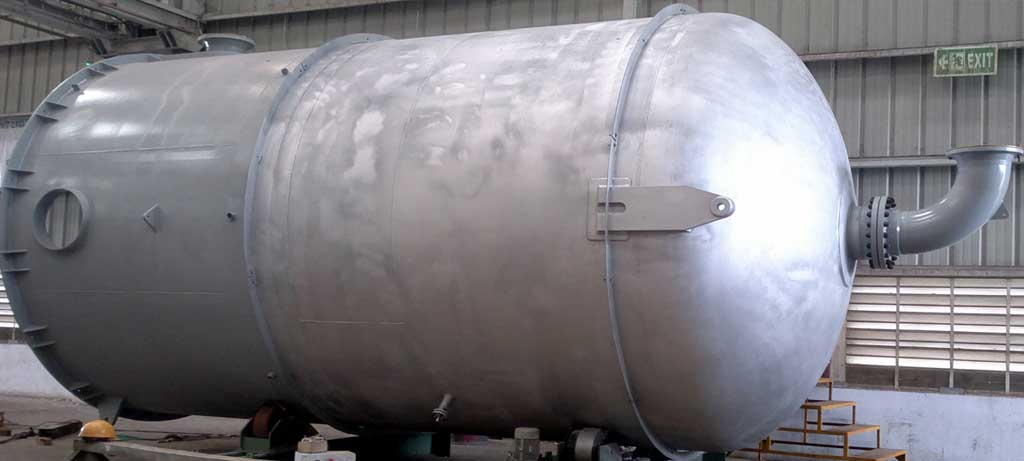A pressure vessel is a container designed to hold gases or liquids at pressures higher or lower than atmospheric pressure. These vessels are fundamental in industries like chemical processing, oil & gas, pharmaceuticals, and power generation. They ensure safe storage and handling of pressurized fluids while maintaining operational efficiency.
Pressure vessels are engineered to meet strict design codes, safety standards, and material specifications, ensuring reliability in demanding industrial environments.
What is a Pressure Vessel?
A pressure vessel is not just a tank; it is a highly engineered container designed to store, transport, or process pressurized fluids. Depending on their application, pressure vessels can operate under extreme conditions, such as high temperatures, cryogenic conditions, or corrosive environments.
Key features include:
- High structural strength to withstand internal and external pressures.
- Leak-proof design to prevent fluid escape.
- Durable materials like carbon steel, stainless steel, and alloys.
- Compliance with international standards like ASME Section VIII, PED, and IS codes.
Types of Pressure Vessels
Pressure vessels are classified based on their function, shape, and industry use:
1. Storage Vessels
These vessels store gases or liquids under pressure, such as LPG tanks, cryogenic storage, and chemical tanks.
2. Heat Exchangers
Pressure vessels can act as heat exchangers, transferring heat between two fluids without mixing. They are essential in power plants, refineries, and chemical industries.
3. Boilers
Boilers generate steam under pressure for industrial heating, power generation, and manufacturing processes.
4. Reactors
Reactors facilitate controlled chemical reactions under pressure and temperature conditions. They are common in pharmaceutical and chemical industries.
5. Process Vessels
These include separators, distillation columns, and flash drums, widely used in refineries and petrochemical plants.
Design and Engineering of Pressure Vessels
The design of a pressure vessel ensures safety, durability, and efficiency. Key aspects include:
1. Design Standards
Compliance with design codes is crucial:
- ASME Boiler and Pressure Vessel Code (BPVC) – global standard.
- Pressure Equipment Directive (PED) – European standard.
- Indian Standards (IS codes) – for local applications.
2. Critical Design Parameters
- Operating Pressure and Temperature – determines wall thickness and material.
- Corrosion Allowance – ensures longevity in corrosive environments.
- Stress Analysis – prevents structural failure.
- Safety Factor – accommodates unexpected loads or conditions.
3. Vessel Shapes
- Spherical – ideal for high-pressure storage.
- Cylindrical – common and easy to manufacture.
- Conical – used for mixing, separation, or flow control.
Materials Used in Pressure Vessels
Material selection is critical for durability and safety:
- Carbon Steel – cost-effective, widely used for storage tanks.
- Stainless Steel – corrosion-resistant, suitable for chemical and food industries.
- Nickel Alloys – for high-temperature and highly corrosive environments.
- Aluminum – lightweight and resistant to specific chemicals.
Material choice depends on pressure, temperature, fluid type, and safety requirements.
Applications of Pressure Vessels
Pressure vessels are indispensable across multiple industries:
1. Oil and Gas
- Storage of LPG, natural gas, and crude oil.
- Separators for oil, gas, and water mixtures.
2. Chemical Industry
- Reactors for chemical synthesis.
- Storage of hazardous chemicals.
3. Power Generation
- Boilers for steam production.
- Heat exchangers for cooling and heating operations.
4. Food and Beverage Industry
- Sterilization and pasteurization equipment.
- Carbonated beverage storage.
5. Pharmaceutical Industry
- Bioreactors and sterile vessels.
- Equipment for controlled drug manufacturing.
6. Water Treatment
- Pressure filters and desalination vessels.
Advantages of Pressure Vessels
- Enhanced Safety – store hazardous fluids under pressure securely.
- Operational Efficiency – improves industrial productivity.
- Durable Construction – withstands high-pressure, temperature, and corrosive conditions.
- Versatility – applicable across multiple industries.
- Cost-Effectiveness – reduces downtime and operational risk.
Common Challenges and Risks
Despite their importance, pressure vessels carry risks:
- Corrosion – can reduce lifespan if not managed.
- Fatigue and Cracking – caused by repeated stress cycles.
- Over-Pressure – may lead to catastrophic failure.
- Maintenance Neglect – increases the probability of accidents.
Proper inspection, maintenance, and compliance with safety standards are essential.
Inspection and Maintenance
Regular inspection and maintenance are critical to ensure safety:
- Visual Inspection – detect corrosion, cracks, or leaks.
- Ultrasonic Testing (UT) – measure wall thickness.
- Magnetic Particle Inspection (MPI) – identify surface defects.
- Radiographic Testing (RT) – detect hidden flaws.
- Hydrostatic Testing – confirm pressure resistance under water.
Maintenance schedules improve lifespan and operational safety.
Future of Pressure Vessels
The demand for pressure vessels is increasing due to advances in renewable energy, hydrogen storage, and green technologies. Emerging trends include:
- Composite Materials – lighter and stronger vessels.
- Smart Monitoring – real-time sensors for pressure and leak detection.
- Eco-Friendly Coatings – improved corrosion resistance.
- Hydrogen Storage Vessels – supporting clean energy solutions.
Conclusion
Pressure vessels are the backbone of many industrial operations. Their ability to safely store and process high-pressure fluids makes them essential across oil & gas, chemical, power, pharmaceutical, and food industries.






